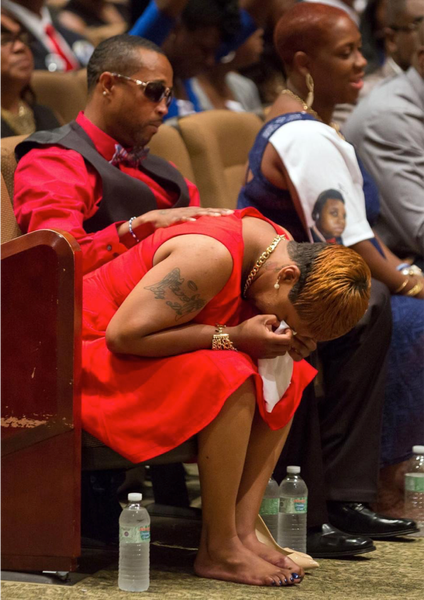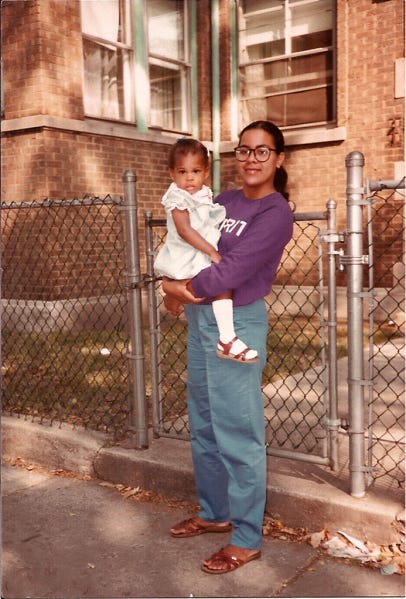Since the sundown of Diaspora Hypertext the Blog (dh.jmjafrx.com) due to malware attacks, I’ve been pulling posts down to find a way to archive them in a meaningful way. Eventually, the entire blog’s raw copy will go on Git where I keep a resources page of various items. But a few I think I’d like to reshare here as well.
This is a post I wrote in 2014 for women reVamped, an organization run by Breannah Alexander for a series on (re)defining feminism. Since then, women reVamped has revamped and relaunched as “a network of donors to create accessible streams of grant funding and capacity building support that centers women of color and gender expansive people of color in their work to transform their communities.” To learn more and support the work, visit https://www.womenrevamped.org/about.
Rereading this post-Trump and the second/third wave of a deadly pandemic, 2014 seems like a thousand years ago. The Kitchen Table praxis, however, remains. Giving thanks for the power of reflection, humility, and continuous revision/reshaping.
Originally - dh.jmjafrx.com, reposed from womenrevamped.org
title: "Fury and Joy: Feminism at the Kitchen Table"
date: "2014-11-14"
Fury and Joy: Feminism at the Kitchen Table
Part of me wants to write about my own upbringing. I am the daughter of a single, Puerto Rican mother who should have divorced her husband (my father) sooner and who never made me feel like being visibly of African descent could lead to shame. How? She gloried over my kinky hair, the way the sun melted down into my brown skin, thick thighs and hips, even the gap between my front teeth. She never mentioned how becoming the gap was beyond the United States, in West Indian and West African contexts, and she might not have known. What she did know was easy—I was a thing of beauty, something amazing she’d created, and when I was sent out into the world I took her blessing everywhere with me. Doubt I am loved? NEVER. My feminism resides in this love.
Part of me wants to write about sex, its physical and emotional intimacy, and how important it is to my politics and my self-care. This part of me would point you to work by Bianca Laureano of Latinx Sexuality and the Latinegrxs Project. I would encourage you to browse the #AfrxLatinxSex Storify where afrxlatinxs from across the country discuss how sexuality and sexual health intersected with their latinidad and understandings of blackness. I’d point you to work by Joan Morgan and the collaboration between her, Treva Lindsey, Brittney Cooper, and Kaila Afrkete Story, also known as the ‘Pleasure Ninjas.’ I’d also send you to the Sex Worker’s Project, which operates out of New York City, and is one of several grassroots organizations in the city and across the country working to make labor conditions fair, safe, and shame-free for for sex workers and clients. My feminism is very sex-positive.

Part of me wants to write about Ferguson and cases of police violence around the country, speaking the names of the dead into the silence of my room. As the city of St. Louis waits for the grand jury to make a decision on whether or not to convict Darren Wilson for the killing of Mike Brown last August, I return again and again to the Storify created by @deray of tweets from those first few days. I think about Lesley McSpadden, Brown’s mother, wearing a resplendent red dress at the funeral, a point noted across social media as Twitter memorialized Brown in digital time and space. My feminism is the spirit of abolition, it is futuristic, and it is digital.
Nowhere, however, would I write about what a good or bad feminist is or represents. My feminism does not require me to choose one of these issues as THE issue I need to focus on to be a proper feminist. How could it? At this point, women of color, some identifying as feminists and some not, have described the impact of race, class, gender, sexuality, and more on their lives in tracts, letters, art, and speeches for a century and more—from Mariah Stewart’s speeches to Anna Julia Cooper’s A Voice of the South to Barbara Smith and the founders of the Kitchen Table Press in 1980. In 1981, Cherríe Moraga and Gloria Anzaldúa published This Bridge Called My Back: Writings by Radical Women of Color with that same press, a historic and groundbreaking text. In it black feminist and radical women/womyn of color activists, artists, and scholars described the impact racism, sexism, patriarchy, classism, and settler-colonialism had on their lives. Their feminism was rooted in ways they encountered these systems of oppression on a daily basis and how their battle for their lives and right to live used strategies articulated by their mothers, grandmothers, and ancestresses around kitchen tables generations before. Art. Spirit. Organizing in each others kitchens, front yards, break rooms, playgrounds while children played, and classrooms. Neither the editors of the volume nor the contributors expressed perfect conceptions of feminism, community, or freedom—transphobia abounded, classism and internalized racism lingered—but there was never any doubt that as women, some straight, many queer, some of African descent, others of East and South Asian, Latinx, Latin-American, and Native American descent, fighting across a spectrum of issues was NECESSARY.
A more recent example—
Black Lives Matters represents a movement and a global community of activists challenging police violence and fighting to save all black lives from extralegal and extrajudicial murder. Well before Michelle Alexander wrote the New Jim Crow: Mass Incarceration in the Age of Colorblindness, organizations like Critical Resistance and INCITE! Women, Gender Non-Conforming, and Trans people of Color* were organizing against police brutality and prisons while encouraging communities to find alternate ways to find justice and create safe spaces. State violence is an issue that impacts black and brown people (men, women, and children) at a disproportionate rate. But that doesn’t mean it impacts all black and brown people in the same way. Alicia Garza of the National Domestic Workers Alliance described starting #BlackLivesMatter with Patrisse Cullors and Opal Tometti after Trayvon Martin was shot by George Zimmerman, but watching the work of queer activists be erased from the story. When reinterpreted by outsiders, the broad focus of the work narrowed to focus on state violence against black men and boys:
“I was surprised when a community institution wrote asking us to provide materials and action steps for an art show they were curating, entitled “Our Lives Matter.” When questioned about who was involved and why they felt the need to change the very specific call and demand around Black lives to “our lives,” I was told the artists decided it needed to be more inclusive of all people of color. I was even more surprised when, in the promotion of their event, one of the artists conducted an interview that completely erased the origins of their work–rooted in the labor and love of queer Black women.”
“Pause.
“When you design an event / campaign / et cetera based on the work of queer Black women, don’t invite them to participate in shaping it, but ask them to provide materials and ideas for next steps for said event, that is racism in practice. It’s also hetero-patriarchal. Straight men, unintentionally or intentionally, have taken the work of queer Black women and erased our contributions. Perhaps if we were the charismatic Black men many are rallying around these days, it would have been a different story, but being Black queer women in this society (and apparently within these movements) tends to equal invisibility and non-relevancy.”
The most radical feature of the Black Lives Matter movement is how explicitly anti-oppression it is at all levels—anti-ableism, anti-transphobia, anti-misogyny, anti-shame and anti-elder veneration. In an October interview, youth working on the ground in Ferguson were interviewed by Darnell Moore of The Feminist Wire. They discussed being queer, being part of a movement led by other queer people of color, and ways their organizing principles were rooted in their identity as black and brown people of color literally fearing for their lives in the face of a militarized police force and the country’s “anti-black policies, practices, and ideologies.” Their practice of engaging on social media is rapid-fire evidence of what an organizing practice looks like when it decenters veneration (including veneration of black men as prototypical victims and/or movement leaders) and centers justice for EVERYONE in the community. Working online and in real life, the Ferguson activists use social media to organize direct action and long-term campaigns, send support and love notes, speak back to mainstream media’s representation of what is happening in Ferguson (including #FergusonFireside conference calls with live updates from activists on the ground, a newsletter and #FergusonFridays Twittter chats 12-1 CST), and offer broad critiques of everything from U.S. empire to legacies of slavery. It is the beloved community at work.
I am a (cis-gender, bi-femme) woman of Puerto Rican and African-American descent before all else and I am black on both sides. It is my duty to fight for my own liberation by centering those most vulnerable to violence, by fighting for myself, and organizing in my community for change. As kin to the kitchen table, I am accountable to it and to the intersection of activism and oppression Garza is describing. I am also in love with it as a space, as a home and homeland. It is ever present to me. My mother, aunt, grandmothers, sisters, and every woman in my life–they are blessings. They save me from myself over and over, again and again.
Because of them, my feminism is a fury and a fierce joy. It is an ACTION. It is also a discomfort, as I challenge myself to recognize ways I am privileged as a cis woman of color, as someone able-bodied, as someone with a well-paying job at any academic institution with time to even imagine writing this blog post. My feminism is not passive and it isn’t a revelation story and it doesn’t come with clean edges or fuzzy feelings. It isn’t a joy-comes-in-the-morning kind of tale. It isn’t good or bad.
It is a messy, makes mistakes, picks itself up and tries again in the morning dark comedy. It is a soul food eating, hard drinking, jukin’ all night, 30 degrees below in the winter, black girl from Chicago story. It is also a sweaty, Spanglish, coquito sucking, tank tops and hoop earrings wearing, child of land and water kind of story. This is where it comes from. This is where I was born.
I am obsessed with kinship and history. This is how my feminism found me.





Loved finding this in my inbox. It's been one of my favorite pieces of writing since I came across it a few years ago. Thanks for always writing.